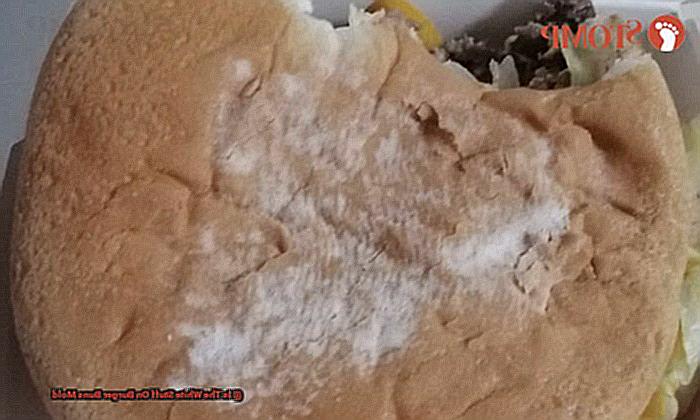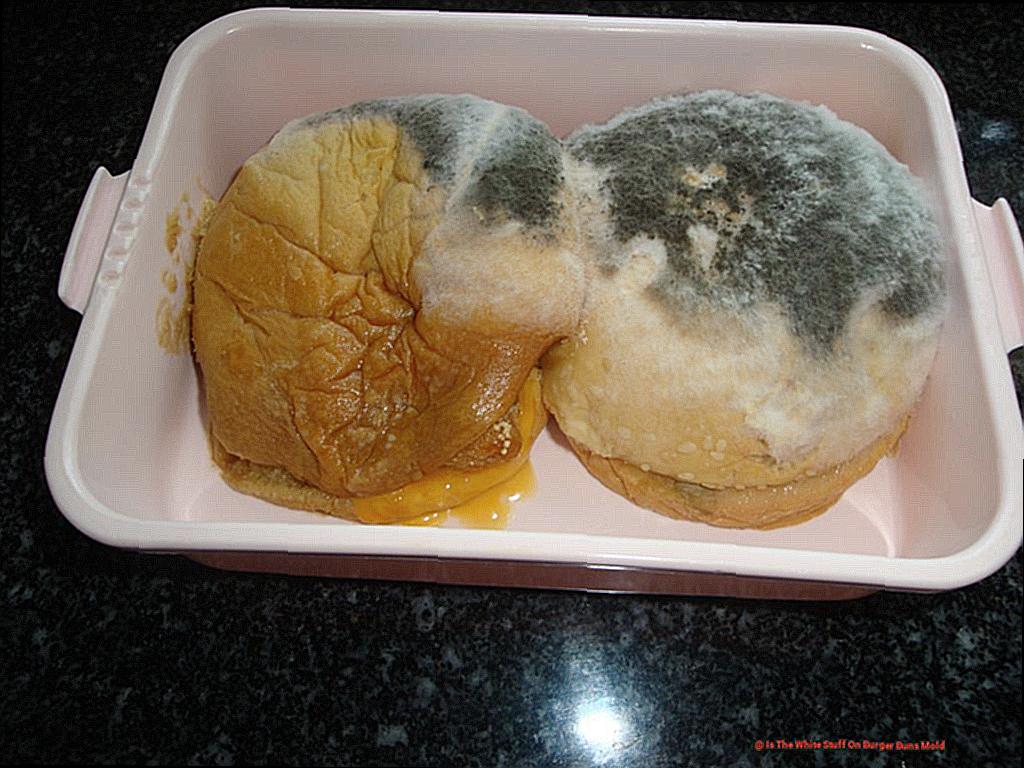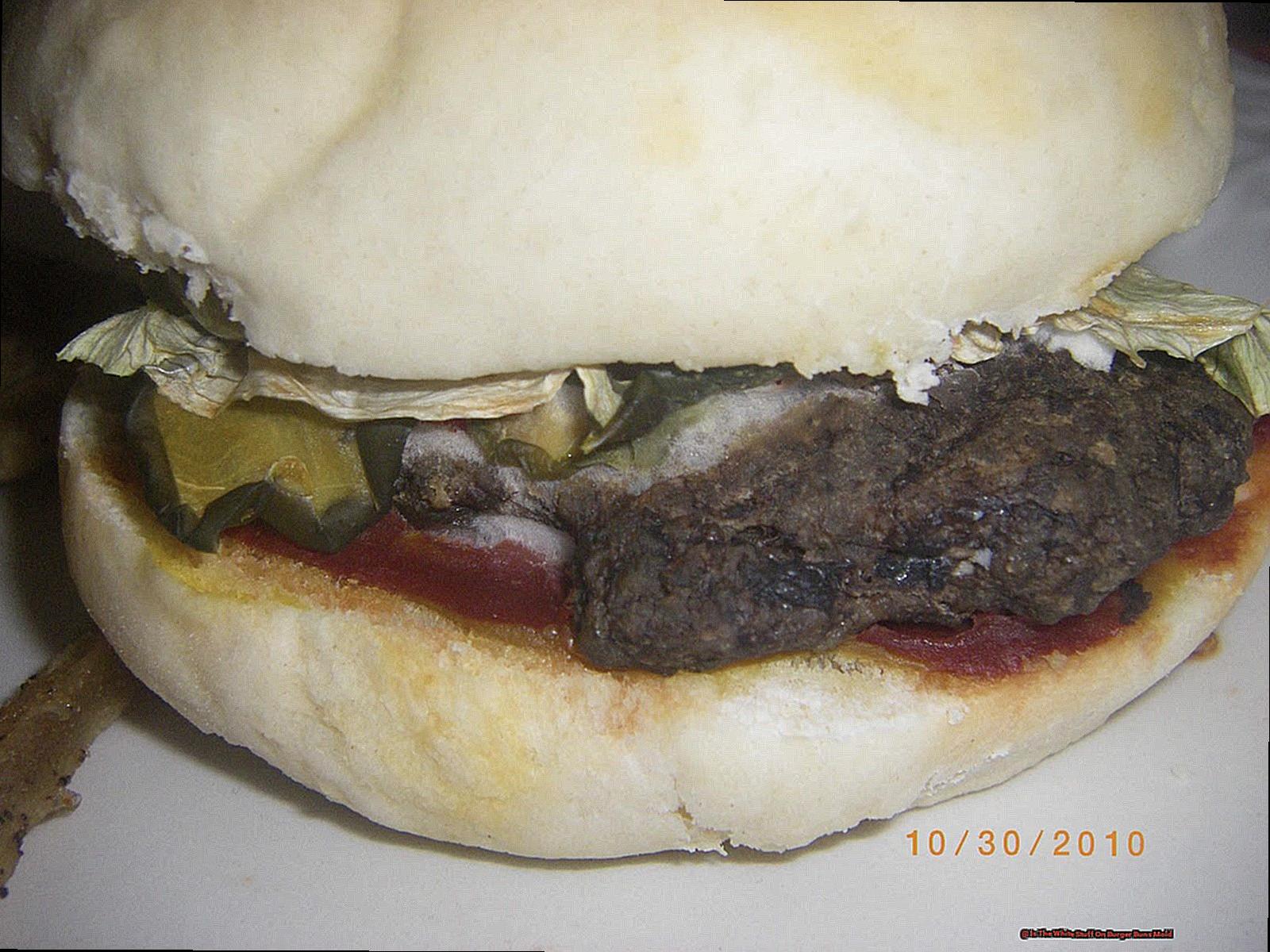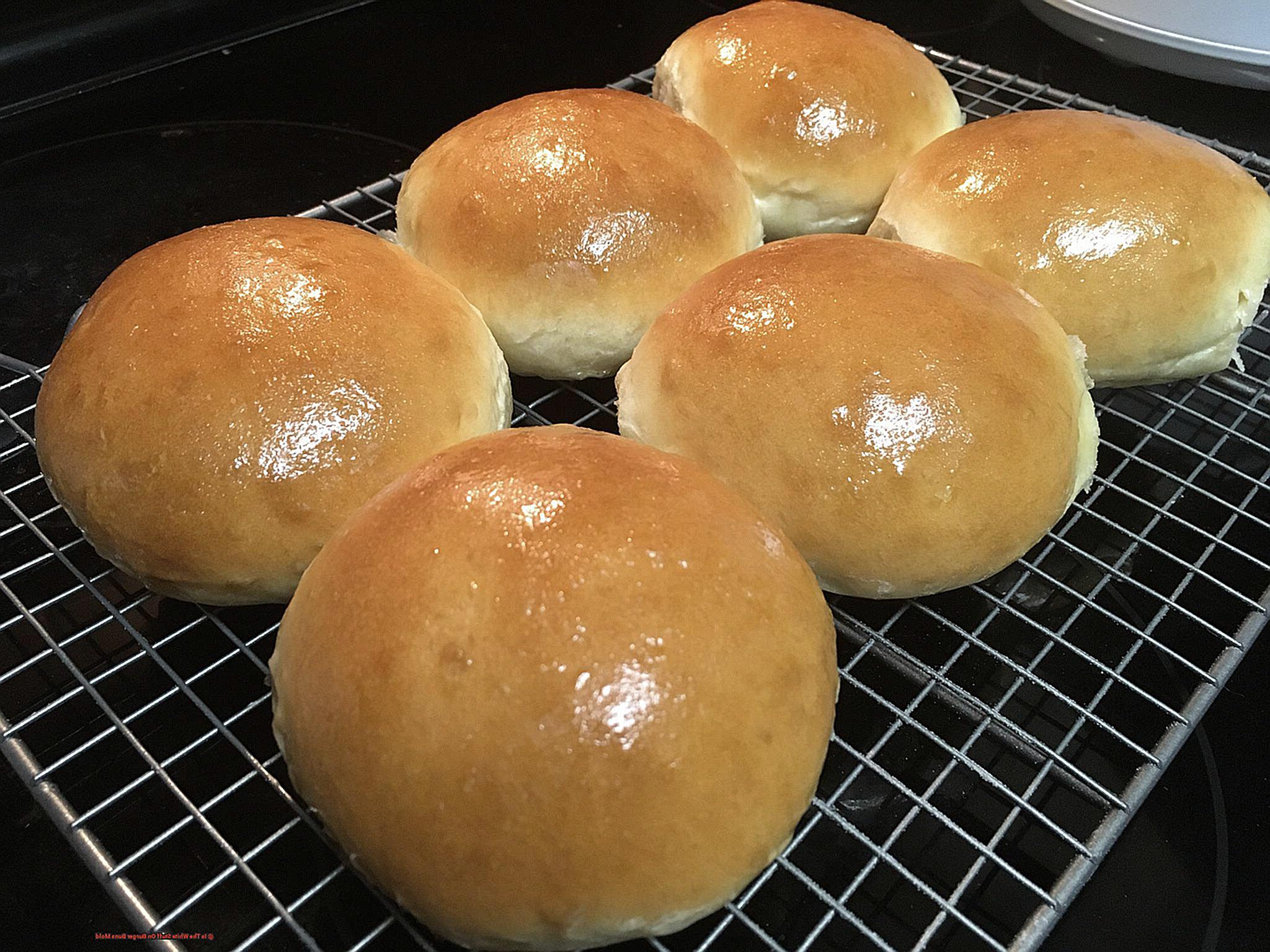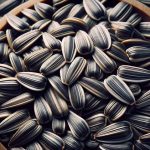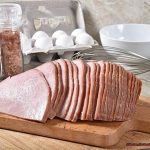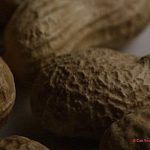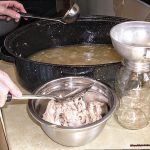Burgers are a beloved staple in the fast food world, but have you ever noticed a strange white substance on your burger bun? It’s a common sight that has sparked much debate and confusion among burger lovers. Is it mold? Should you be concerned about eating it? In this blog post, we’ll delve into the truth behind this mysterious white stuff and provide some answers. So before you take another bite of your favorite burger, let’s uncover the truth:
Many assume that the white substance is mold, but don’t jump to conclusions just yet. Mold needs moisture to grow and most burger buns are baked at high temperatures, making it difficult for mold to survive. So what could it be? Some experts suggest that it could be flour dust or starch residue from the baking process.
However, others argue that it could still potentially be mold as bakeries may add preservatives to extend shelf life. This adds an interesting twist to the debate. Is the white stuff truly harmless or should we be more cautious?
We’ll explore both sides of the argument and provide tips on how to identify mold on your burger bun. Because let’s face it, no one wants to bite into a moldy bun.
So, join us as we unravel the mystery of the white substance on burger buns and determine if it’s truly something to worry about. Let’s get started.
Contents
Understanding Mold on Food
When you see white spots on your burger buns, it’s important to know whether it’s flour or mold so you can determine if it’s safe to eat. Here are some tips to help you differentiate between the two:
| White spots | Texture | Color | Odor |
| Powdery | Dusty and crumbly | Bright white | No odor |
| Solid | Fuzzy or slimy | Dull dirty-white or greenish-blue | Musty odor |
If the white spots on your burger buns are powdery and bright white, then most likely it’s just flour dusting and safe to consume. On the other hand, if the spots are solid and fuzzy or slimy with a musty odor, then it’s most likely mold and should not be eaten.
It’s important to remember that inhaling mold spores can be harmful, so avoid smelling it directly. Moreover, consuming moldy bread can cause health issues, so it’s best to throw away the entire loaf if any part is affected.
To prevent mold growth on your bread, try using a bread box with sufficient airflow, purchasing preservative-containing bread, freezing unsliced bread for up to 3 months, or refrigerating in hot climates. By following these tips and tricks, you can easily differentiate between flour and mold on your burger buns or any other type of bread.
Anecdote:
Now let me tell you a personal story about the importance of being able to distinguish between flour and mold on bread. One day, I was making sandwiches for a picnic with my friends. As I was preparing the buns, I noticed some white spots on them. I immediately thought it was mold and was about to throw them away when my friend, who happens to be a baker, stopped me. She told me that it was just flour dusting and completely safe to eat. I was surprised to learn that flour can also cause white spots on bread. From that day on, I’ve been extra careful in checking the texture and odor of white spots on bread before throwing them away.
Remember:
- Check the texture: powdery and bright white is most likely flour, while fuzzy or slimy with a musty odor is mold.
- Avoid smelling mold directly as it can be harmful.
- Discard any bread that shows signs of mold.
- Use these tips to prevent mold growth on your bread.
How Do I Know My Hot Dog Has Mold?
Hot dogs are a popular and convenient food choice, but they can also spoil and become unsafe to eat. Mold is a common culprit for food spoilage, and it can be dangerous to consume.
So, how do you know if your hot dog has mold on it? Let me tell you.
Detecting Visible Signs of Mold
The first and most obvious way to tell if your hot dog has mold on it is by looking for visible signs. Mold often appears as fuzzy or discolored patches on the surface of food. If you see any green, blue, or white spots on your hot dog, mold has likely started to grow.
Trust Your Nose
Another way to detect mold on a hot dog is by smelling it. If the hot dog smells bad or sour, it may have gone bad and could potentially have mold growing on it. Trust your nose and if something smells off, it’s best to err on the side of caution and not consume it.
Check Inside
Sometimes, mold can grow on the inside of a hot dog where it may not be immediately visible. To check for this, slice open the hot dog and inspect the inside for any signs of discoloration or fuzziness.
Expiration Date Matters
Always check the expiration date of your hot dogs before consuming them. If they are past their expiration date, there is a higher chance that mold has started to grow on them.
If you do find mold on your hot dog, do not consume it. Mold can cause allergic reactions and food poisoning symptoms such as nausea, vomiting, and diarrhea. It’s always better to be safe than sorry when it comes to consuming potentially moldy food.
Tips for Prevention:
- Store your hot dogs properly in the refrigerator or freezer to prevent mold growth.
- Purchase only the amount of hot dogs you will consume within a reasonable amount of time.
- If you have leftover hot dogs, freeze them for future use instead of keeping them in the fridge for an extended period.
How Long Does It Take for Mold To Grow on Hot Dogs?
The growth of mold on hot dogs can start as soon as 2 to 3 days if they are not stored correctly. However, the timeline for mold growth can differ depending on various factors such as temperature, moisture levels, and the type of mold present. Here are some key elements that play a role in the growth of mold on hot dogs:
- Temperature: Mold thrives in warm and humid environments with temperatures between 77°F (25°C) and 86°F (30°C) being the most conducive for its growth. This is why it is imperative to store hot dogs in the refrigerator at a temperature lower than 40°F (4°C).
- Moisture: The presence of moisture in hot dogs can accelerate the growth process of mold. Therefore, it is essential to keep them in a dry environment and avoid exposing them to excessive moisture.
- Type of mold: The type of mold found on hot dogs can also impact the timeline for its growth. Certain molds have faster growth rates and may require specific conditions to thrive.
- Amount of organic material: Mold feeds on organic material, making hot dogs an ideal source for its growth. The more organic material present, the faster the mold can grow.
- Exposure to air: Mold requires oxygen to grow, thus exposure to air can also contribute to its growth on hot dogs. It is crucial to properly seal and store hot dogs to prevent air exposure.
| Factors | Timeline for Mold Growth | Preventative Measures |
| Temperature | 2-3 days | Store hot dogs in the refrigerator at a temperature below 40°F (4°C). |
| Moisture | 2-3 days | Keep hot dogs in a dry environment and avoid exposure to excess moisture. |
| Type of mold | Varying | Properly dispose of any spoiled hot dogs and regularly clean storage areas to prevent mold growth. |
| Amount of organic material | 2-3 days | Purchase and consume hot dogs within a reasonable amount of time to minimize organic material for mold to feed on. |
| Exposure to air | 2-3 days | Properly seal and store hot dogs to prevent exposure to air. |
In conclusion, the timeline for mold growth on hot dogs can vary depending on different factors. Thus, it is essential to take preventative measures, such as proper storage and monitoring expiration dates, to ensure safety when consuming them.
Why Mold Like to Grow on Buns?
Burger buns are a prime breeding ground for mold due to various factors, including their ingredients, packaging and storage conditions, and handling and hygiene practices.
Ingredients:
The majority of commercially produced burger buns contain significant amounts of sugar and fat, which are vital components for mold growth. In order to thrive, mold requires moisture, warmth, and nutrients, all of which can be found in abundance in the bun. The high sugar content serves as a food source for mold to feed on, while the fat helps retain moisture, creating a moist environment perfect for mold growth.
Packaging and Storage Conditions:
Burger buns are typically packaged in plastic bags or containers, which trap moisture and create a humid environment for mold to flourish. Furthermore, during transportation and storage, fluctuations in temperature and humidity levels can further promote the growth of mold.
Handling and Hygiene Practices:
Cross-contamination from equipment or surfaces that may have come into contact with mold spores can easily transfer them onto the burger buns, providing an ideal starting point for mold growth. Additionally, poor hygiene practices by workers can introduce bacteria and spores onto the buns, accelerating the growth of mold.
In conclusion, a combination of high sugar and fat content in the ingredients, humid packaging and storage conditions, and potential contamination from handling and poor hygiene practices make burger buns a prime environment for mold to thrive.
How Do You Remove Mold from Sausage?
Mold on sausage is something that can happen quite often, but it’s necessary to handle it with care to avoid any potential health concerns. Here are some steps you can take to safely remove mold from sausage and ensure it is still safe to eat:
- Assess if the sausage is still safe for consumption: Before attempting to remove mold from sausage, it’s crucial to evaluate whether it is still safe to eat. If the mold is only on the surface and the sausage doesn’t have a foul smell, it may be safe to consume after removing the mold. However, if the mold has penetrated the sausage and has a strong odor or slimy texture, it’s best to discard it.
- Wear protective gear: When handling moldy food, it’s important to wear gloves and a mask to avoid direct contact with the mold and its spores.
- Cut off the affected area: If the mold is only on a small section of the sausage, you can simply cut off the affected area with a clean knife and dispose of it. Be sure to cut at least 1 inch around and below the moldy spot to ensure all visible spores are removed.
- Rinse the remaining sausage: After removing the moldy section, rinse the remaining sausage under running water to remove any remaining spores.
- Sanitize utensils and surfaces: Any utensils or surfaces that came in contact with the moldy sausage should be thoroughly washed and sanitized to prevent cross-contamination.
- Cook thoroughly: Cooking the sausage at a high temperature (above 165°F) will kill any remaining bacteria or mold spores, making it safe to eat.
It’s important to note that these steps may not be effective for all types of molds. Some molds can produce toxins that can penetrate deep into the food, making it unsafe to consume even after removing visible mold. If you’re unsure about the safety of your sausage, it’s best to discard it and err on the side of caution.
Prevention is the best way to avoid dealing with moldy sausage. Proper storage and handling can help prevent the growth of mold on your food. Sausage should be stored in a cool, dry place and consumed within a few days after purchase. Be sure to check for any signs of mold before consuming and dispose of any spoiled or expired products.
To conclude, while mold on sausage may not be appealing, it’s important to handle it carefully and take necessary precautions to prevent any potential health risks.
Can You Remove Mold on Part of the Bread?
Unfortunately, consuming a piece of bread with mold on even just one part is not safe. This is because mold has long roots that can spread throughout airy baked goods, making it impossible to simply remove the affected area and still consume the rest of the bread. Moreover, even if a small spot of mold is visible, there could still be microscopic mold spores in the rest of the loaf that can cause illness if consumed.
Hence, the most prudent course of action is to discard the entire loaf of bread upon seeing any signs of mold. This includes any slices of bread that may be adjacent to the affected area, as mold can easily spread from one slice to another.
Prevention is crucial in avoiding mold on bread. Properly storing bread in a cool and dry place can help prevent mold growth. It is also important to regularly check your bread for any signs of mold before consumption. In case you do find mold on a loaf of bread, it is best to buy a new loaf rather than risk getting sick from consuming contaminated bread.
However, if you have a bagged loaf of sliced bread and only one end is free from mold, it is possible to save the rest of the loaf by trimming off the affected end and checking for any other green spots.
Be sure to rinse the remaining slices and sanitize any utensils or surfaces that may have come into contact with the moldy slice.
Is Eating A Hot Dog With White Mold Still Safe?
When it comes to consuming food, especially those with any type of mold such as white mold on hot dogs, it’s always better to err on the side of caution. Although some kinds of mold may not be harmful, they can indicate spoilage and potentially lead to food-borne illnesses.
To determine if a hot dog with white mold is still safe to eat, consider the following factors:
- Presence and extent of mold growth – If the mold is only present on the surface of the hot dog and can be easily wiped off, it’s likely that the rest of the hot dog is still safe to consume. However, if there is extensive mold growth throughout the hot dog, it’s best to discard it.
- Texture and appearance – Moldy hot dogs may have a slimy or fuzzy texture and may also look discolored or have a pungent odor. These are all signs of spoilage and indicate that the hot dog is not safe to eat.
- Expiration date – Check the expiration date on the package of hot dogs. If they are past their expiration date, it’s best to discard them regardless of the presence of mold.
- Storage conditions – Hot dogs should be kept in a cool and dry place to prevent mold growth. If they were stored in a warm and humid environment, there is a higher chance of mold growth and spoilage.
In short, if you come across a hot dog with white mold, it’s best to discard it to avoid potential health risks. Be sure to regularly inspect and clean storage areas for signs of moisture or fungus growth to prevent future occurrences. So, be cautious when consuming food with any type of mold, including white mold on hot dogs.
Conclusion
In conclusion, the enigmatic white substance found on burger buns has sparked much debate and confusion among burger enthusiasts.
While many assume it to be mold, this may not always be the case. It could simply be flour dust or starch residue from the baking process.
However, it is crucial to know how to differentiate between mold and harmless substances on your burger bun and take necessary precautions to avoid consuming it. The same applies to hot dogs, as mold can also grow on them if not stored properly.
It is imperative to understand the contributing factors of mold growth and take preventative measures for food safety. Remember, when in doubt, prioritize your health by discarding potentially moldy food.
